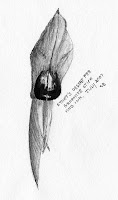 As some of you know I am working on an oil painting that is worked as a grisaille then glazes of transparent colour layered over the top. Because it is a landscape I am also introducing opaque colour as well with texture and the two seem to be work together; probably as the scene is water, smooth rock and native bush.
As some of you know I am working on an oil painting that is worked as a grisaille then glazes of transparent colour layered over the top. Because it is a landscape I am also introducing opaque colour as well with texture and the two seem to be work together; probably as the scene is water, smooth rock and native bush.For those that wonder about the pronunciation of grisaille it is grizz-eye; French for grey.
The grisaille technique can be used in any colour that an artist wishes to choose although shades of grey or brown is more common. What you end up with is a monochromatic painting done entirely with a number of steps of values in one colour. This technique was common among the artists of the early Renaissance.
Using the grisaille technique the values are all worked out before any colour is added, not that hues are always introduced to the work. If you choose to go to the next step and add colour, the rest seems to take on a life of its own with changes happening very quickly because you don't have to concentrate quite so much on the values as they are already mapped out.
There are two artists at WetCanvas who's work I do admire. They are William F. Martin and Martin Clarke; both generously demonstrate there grisaille techniques on WetCanvas.
Samples of William's work in progress:
Samples of Martin's work in progress:
I personally would like to study this grisaille technique in depth and if anyone has good links on this subject that they would like to share with me and my readers please leave them in the comments of this post. I have to admit I found searching the internet rather lacking when it comes to information on this subject.Quick links:
![]() technorati tags: grisaille,
technorati tags: grisaille,
6 comments:
The problem I have had always with this technique (or any other that involves study) is that I cannot stop at a point. I just have to go overboard and complete the work - that leaves me with less study than I desired.
I tend to have the problem of loosing a lot of time trying to find the information that I am looking for when trying new techniques that are unfamiliar to me. The painting on the easel ends up progressing at a much slower rate because of my searching. It certainly avoid boredom. :D
I use this method with gray pastels. I have one set of Sakura carre hard pastels that has five steps of warm, and five of cool gray. I also have my soft pastel grays in a separate cigar box, divided by temp. and ordered by value.
I will draw the linear composition, and then complete the value study in grays.
It is a simple matter to now add hues that match the values of the gray scale study. Perhaps now we don't have a Grisaille anymore?
My pastel work done this way may lack the glazing aspect, but it wouldn't have to. Colors will also lack intensity, but nothing keeps one from redoing the work later.
I never knew it had a French name, but then again, doesn't everything?
I have never use the grisaille method with my pastel work and would be interesting to try.
Also I do like the way you organise your pastels; the colours in your 'Installation' post make for some nice eye candy. :D
Susan - watch out for my weekly round-up on Sunday. It has a video on this topic which will interest you.
Have you done a search on WC - I've seen a fair bit about grisaille on my travels
You have me intrigued about your post for Sunday Katherine. :D
As to finding more information about the grisaille technique, yes I have searched on WetCanvas and probably could even spend more time doing so. Perhaps I am looking for something in great depth without knowing what it is I am actually looking for. Maybe I am romanticizing the technique without more to be found. ;-)
If I do find something that possibly is of interest I will share the links here at my blog.
Post a Comment